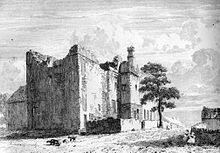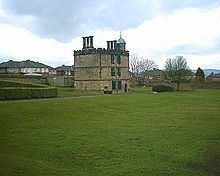- Sheffield Manor
-
Sheffield Manor, also known as the Manor Lodge or Manor Castle, is a lodge built about 1516 in what then was a large deer park east of Sheffield, South Yorkshire, UK, to provide a country retreat and further accommodate George Talbot, the 4th Earl of Shrewsbury, and his large family.[1] The remnant of this estate is now known as Norfolk Park.
The remains of Sheffield Manor include parts of the kitchens, long gallery, and the Grade II* listed Turret House, which contains fine seventeenth-century ceilings.
Contents
Mary, Queen of Scots
Mary, Queen of Scots, was held prisoner by the 6th Earl of Shrewsbury at both Sheffield Manor and Sheffield Castle (her ghost is said by some to haunt the Turret House building). Wolsey’s Tower was built to accommodate Cardinal Wolsey, who then died after travelling on to Leicester.
Mary escaped to England in 1568 seeking the support of the Catholic nobility. Mary's freedom was restricted after her cousin Elizabeth was advised of the threat that Mary posed to her own crown.
She was handed over to the custody of George Talbot, 6th Earl of Shrewsbury on 4 February 1569. She was not closely guarded, however, and was able, with the help of the Duke of Norfolk and others of the Catholic nobility, to plot against Elizabeth. Several times Mary had to be moved to places of greater safety and stricter control.
On 28 November 1570 she was taken to the Earl of Shrewsbury's castle, where, apart from a few breaks at Chatsworth and Buxton, and more regular visits to the Manor House, she remained for 14 years.
Despite Mary's actions, Elizabeth still seemed to support her cousin's claim to the Scottish throne, and Mary wrote regularly to her supporters in Scotland asking them to be faithful and to await the help she believed Elizabeth would provide. Two letters containing her writing are preserved in the Sheffield Archives.
The Duke of Norfolk, not long released from the Tower of London, was caught in collusion with the papal agent Roberto di Ridolfi plotting to bring about a Catholic uprising in England. Parliament demanded the execution of both Mary Stuart and Norfolk. At this stage no action was taken against Mary, but the Duke of Norfolk was beheaded in 1572.
In 1582, while Mary was still being held at Sheffield, an inventory of all the household goods and furniture belonging to George, Earl of Shrewsbury was made. The inventory describes the castle and contents and gives an idea of the types of rooms in the castle at this date. These included a chapel, a porch going into the great hall from the great chamber (which was probably the large dining room), a wardrobe, the Lord's chamber and outer chamber, the Lady's chamber, a bakehouse, brewhouse, pantry, washhouse and low washhouse, a round tower, a square tower and a turret, round towers on either side of the gatehouse and walls running along the waterside, a porter's lodge, a dungeon, a square room, little kitchen, old kitchen, a kennel and a range of stables.
Also included in the inventory is the "stuff" of the "Queen of Scots and her people". Mary had with her a large entourage, which varied over time, made up of Scots, French and English friends and servants. The list of rooms for "her people" includes those of the Master of the "quences howsholde", a Mr Burgon as her doctor and a Mr Jarvys as her "surgion".
The 1582 survey also lists the furnishings "in the hawle at the Poandes", now known as the Old Queen's Head.
In August 1584 Queen Elizabeth finally agreed to Earl George's petition releasing him from his duty of Mary's care—a task which had broken his marriage, his health and his chances of further political advancement. After leaving Sheffield, Mary was taken to Wingfield Manor in Derbyshire by her new gaoler, Sir Ralph Sadler, and then to Tutbury. From there she went to Chartley Manor in Staffordshire, where she became involved in the Babington Plot.
Duke of Norfolk
After Sheffield Manor fell into the hands of the Duke of Norfolk, it was neglected, sold to tenant farmers, and largely dismantled in 1706. Some remaining walls and a window were removed to the grounds of Queen's Tower in Norfolk Park by Robert Marnock in 1839. In 1953 the Duke of Norfolk Estate leased the site to Sheffield City Council for 999 years.[2]
"Restoration" plan
In 2004, the building featured on the BBC TV programme Restoration and was the subject of a National Lottery funding bid to convert it to a heritage centre and traditional farm. The housing estate of Manor is named after Sheffield Manor. Green Estate, which was established by the Manor and Castle Development Trust and Sheffield Wildlife Trust, has received £1.25 million from the Heritage Lottery Fund to develop the site as a visitor attraction.[2]
References
- ^ Pollard, A. F. George Talbot, fourth Earl of Shrewsbury. Dictionary of National Biography. Vol LV. Sidney Lee, Ed. New York: The Macmillan Co., 1898. 313-314.
- ^ a b Lucy, Ashton (26 June 2007). "Historic monument handed over to group to be developed". The Star (Sheffield Newspapers Ltd.). http://www.thestar.co.uk/news?articleid=2979749. Retrieved 2007-06-28.
External links
Listed buildings in Sheffield Grade I Grade II* Abbeydale Industrial Hamlet Housing • Arts Tower and Library • Beauchief Abbey • Beauchief Hall • Beehive Works • Bishops' House • Butchers Wheel • City Hall • Cornish Place • Cutlers' Hall • Ecclesfield Priory • Endcliffe Hall • Fair House Farmhouse • General Cemetery • Globe Works • Green Lane Works Gateway • Heritage House • King Edward VII Upper School • Leah's Yard • Little Matlock Rolling Mill • Lyceum Theatre • Manor Lodge Turret House • Mappin Art Gallery • The Mount • Mount Pleasant • Norton Hall Hospital • Oakes Park • Old Queen's Head • Onesacre Hall • Paradise Square • Park Hill Flats • St James, Midhopestones • St James, Norton • St Mary, Bramall Lane • St Mary the Virgin, Beighton • St Paul, Wordsworth Avenue • Sanderson Kayer's Darnall Works • Sharrow Mills • Victoria Quays Terminal Warehouse • Well Meadow Street Crucible Furnace • Whitley Hall Hotel • Wicker ArchesLists City Centre • S2 • S3 • S4 • S5 • S6 • S7 • S8 • S9 • S10 • S11 • S12 • S13 • S14 • S17 • S20Coordinates: 53°22′27″N 1°26′12″W / 53.374031°N 1.436656°W
Categories:- 1510s architecture
- Buildings and structures in Sheffield
- Grade II* listed buildings in Sheffield
- Country houses in South Yorkshire
- History of Sheffield
- Scheduled Ancient Monuments in South Yorkshire
- Manor houses in England
Wikimedia Foundation. 2010.


